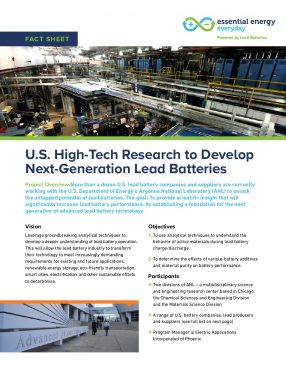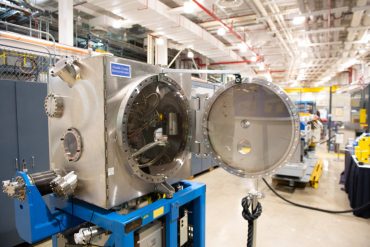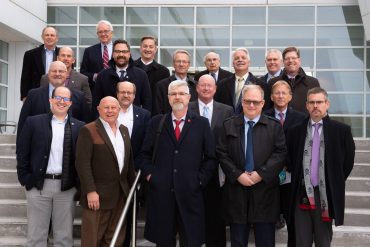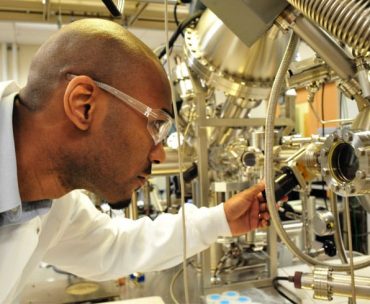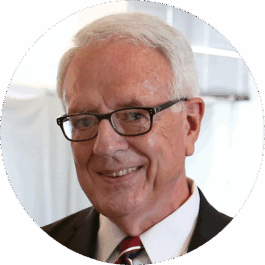
The U.S. Department of Energy and the U.S. lead battery industry are collaborating on an initiative to unlock the full potential of lead battery technology. The research project occurring at Argonne National Lab (ANL) in Chicago, is using the Advanced Photon Source (APS) – one of the world’s premier high-energy synchrotrons – to study electrochemical reactions in real time.
We had a chance to visit ANL and talk with Dr. Venkat Srinivasan about the project. He is the director of the Argonne Collaborative Center for Energy Storage Science (ACCESS) and deputy director of the Joint Center for Energy Storage Research (JCESR). [NOTE: The original conversation has been condensed.]
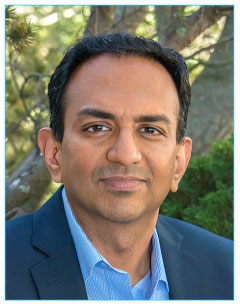
Q. Argonne battery scientists focus on next-generation storage research. Why is this needed?
Dr. Srinivasan: We need batteries that are cheaper, can last longer, can be safer, and can charge faster than the ones we have today. We need new materials that can … satisfy the requirements. ACCESS is committed to … work with various partners, including the federal government and industry, and take these innovations from lab … to market, and create … the future of transportation, the future of the grid.
Q. What does that look like?
Dr. Srinivasan: Argonne has tremendous capabilities. We are at the APS, one of the premier light sources in the world. We have everything from basic science … all the way to scale-up facilities … testing facilities … and, ultimately, understanding how [batteries] can be recycled in the real world.
ACCESS puts together teams of people that have very different skill sets … chemical engineers, chemists, material scientists, physicists, … people that do theory, people that do experiments. Ultimately, this team is the one that can have an impact.
Q. What is the role of national laboratories in the R&D of battery technologies?
Dr. Srinivasan: We are all about trying to work on big problems. [Once] we solve the problems, … [we move] innovations out to the real world, so that people can use [them]. Energy storage is a big problem. We need better batteries for the future. We need National Labs to … think about what the world is going to look like five years from now, 10 years from now, … and start to … create that world by creating the devices, the technologies and the knowledge needed for that world to exist.
Q. How far do you take the research? Do you hand it off, do you commercialize products?
Dr. Srinivasan: National Labs are … not in the business of commercialization. We … take the R&D from its genesis – the innovation – to the point where industry can look at it and say, “We think what you’ve done is enough for us to actually go and put that in the real world and start to manufacture that.” We take it to the scale where we’ve de-risked the technology for industry.
Secondly, often when we have [an] innovation in the lab, we don’t want to just throw it over the fence to industry and ask them to run with it. We want to work with them … closely, because we understand that doing the scale up, doing the manufacturing process, … [putting] it in the market, there could be changes in battery operation that could impact how it is behaving.
Q. Your personal research interest is in developing next-generation batteries for vehicles and grid applications. Where do lead batteries fit into that?
Dr. Srinivasan: The lead acid battery … is legendary. We can recycle 95+ percent of [these] batteries all across the world. It’s a very safe chemistry, … [and] we understand how to use it very, very well.
If you … think about where the world needs to go, we have this huge need to install batteries for grid-cell system, whether for resiliency … for backup power or … to control electricity cost in our homes. I actually view the lead acid battery as a wonderful solution for those applications. But … as the lead acid battery exists, there are some problems. We’re … working with the lead acid battery companies … trying to understand [and solve] those problems. I think this is an under-tapped market where lots of interesting things could be done.
Q. Explain the role batteries have in smart cities and smart roads?
Dr. Srinivasan: Batteries have a large role. It seems like there is a growing trend of this intersection between electrification … and automation, and that trend is going to continue … for the next 10, 15 years. We’re going to be seeing more of these technologies converging, and the crux of the technology is going to be electrification.
A battery is going to hold the key to ensuring that we’ll get to electric cars … converting the mechanical power to electrical power to drive all the electrical systems. There are a lot of efficiencies to gain when you do that also.
I can see … a tremendous future in infrastructure. We’re starting to [hear], “How do we ensure that we have a smart, resilient grid?” And, we’re changing how we use the different resources we have to generate [and use] electricity – this idea of smart controllers that can change the mix of generation and use so that we can satisfy the needs of the consumer, while … minimizing the cost of the total system. There, again, batteries are going to play a crucial role.
Q. Why is it important that government research be invested in battery technology to support our future energy storage needs?
Dr. Srinivasan: In energy storage … much of the innovation we see in the marketplace is because of the government. The Chevy Volt and the Chevy Bolt batteries … [have] Argonne’s intellectual property in them. We see the same IP translating toward good storage where there are many lithium-ion battery companies installing batteries on the grid. Government R&D is really the driver behind finding those innovations and getting [them] to the marketplace.
Q. Can you talk about the scale of what can be done?
Dr. Srinivasan: Innovation comes due to a few different things: People that have deep knowledge … equipment they can use to get things to scale … and, ultimately, you’ve got to get those innovations out to the real world. The DOE and federal government have been fostering all three aspects.
They’ve been fostering people, letting them … do the research, get the experience to understand how to get the next big breakthrough. They’ve provided us … tens of millions, hundreds of millions of dollars of equipment, which no company can do on its own. Third, [they support us in moving] knowledge … out to the real world where we can have an impact.
Q. When do storage technologies begin to look different from those that we have today?
Dr. Srinivasan: Storage technology is constantly improving. The battery from ten years ago is not the same as a battery we have today. Every two or three years, there are new things coming into the marketplace. The consumers don’t see that, but … those innovations are happening constantly.
So ten years from [now], you’re going to see systems that are very different from the kinds of systems today. And, you’re going to see … a much different society, where smart grids are the future and batteries are an integral part of that.
Q. What does this mean for national security that this kind of research is being done in the U.S., in a government lab?
Dr. Srinivasan: Energy storage … [has] all kinds of applications for military uses, whether that is going to be a vehicle that is driving or a soldier [who] is carrying all sorts of devices that need power. At Argonne, one of our strategic areas is to help the U.S. military, get … better powered devices – more energy density, more power density, and faster charging.
Second, there’s a lot of lead acid battery manufacturing happening in the U.S. We want to foster that … for every industry, because [it creates] more jobs [and] helps researchers. We’re able to translate our R&D to the market quickly if there is a manufacturing ecosystem that is building along with the research ecosystem. I would call it ‘U.S. competitiveness.’
Q. You’ve spent a lot of your career in energy storage research. Before ANL got involved with lead batteries, were they considered less exciting to your research colleagues?
Dr. Srinivasan: Historically … there’s been a big push toward high-energy density batteries [lithium-ion] … to make electric cars better. [So] R&D in [lead] acid batteries has fallen off in the last 10, 15, 20 years in the U.S. Now, as the grid becomes more important, the needs of energy density have changed. It’s not … that important anymore. It’s all about cost, and life, and safety.
The community has not adapted to that reality yet. The Lead Acid Battery Consortium, working with ANL, has shown there is much potential for this chemistry. There’s a lot of R&D to be performed, and [it] can have an impact in making [this] battery better. We have to start taking lead very, very seriously. In the next 10, 15 years, we hope these innovations reach the market so that more people … think of lead as a competing technology to all others, including lithium.
Q. Are you seeing a change in attitude toward lead, because of this type of work?
Dr. Srinivasan: As our researchers go to conferences and make presentations, [many] people are starting … to see … a lot of interesting science going on, along with the fact that there’s an interesting market [for lead batteries]. More people are asking questions about the lead industry.
Q. Can you give us your view on the research and collaboration that you’re doing on this project or some other project in the lead industry?
Dr. Srinivasan: We’ve been … working with the companies to understand what … leads lead batteries to failure. An integral part of that is using our advanced characterization tools, both the APS and the Electronic Discovery Lab, to understand things like the role of impurities … how the cell fission process occurs, how does charging impact the way the battery is distributing itself. That … is the fundamental knowledge that we’ve been gaining in the last year. The hope is that [it will help] these companies be successful in making better batteries that last longer.
[This project is a] beautiful example of collaboration. The National Labs can take their incredible resources and work on a problem the industry has but [its companies] don’t have the equipment or the people to [find solutions].
Q. One aspect of being a National Lab is to build unique facilities and capabilities unlike any other in the world. So how do those characteristics benefit lead battery research?
Dr. Srinivasan: We are standing at the APS. It is a premier facility to understand what is happening in these kinds of batteries on an atomic and molecular level. It is a facility … uniquely [suited] to go inside the battery to understand … lead chemistry, to gain this deep understanding. Nobody else can do this, because of the scale at which we look at problems.
Q. Have there been any findings or insights to date? How is the project coming along?
Dr. Srinivasan: The project’s going really, really well. The collaboration has been really successful, from our perspective. We’ve learned a lot about how the [lead] acid battery works … the kinds of markets the battery is used in today, and where they should be used in the future. We’ve learned a lot about [what has been] tried to make the battery better. Because of that, we’re able to understand exactly what is going on in these batteries at the fundamental level.
I believe the [participating] companies are seeing the impact of this understanding, because they’ve come back to us, asked us a lot of questions. We could see the interest from them as they listened to us talk about what we’ve been doing. It’s a win-win from both sides.
Q. Are there other areas of collaboration for the lead industry that can ensure the technology has a role in the future U.S. battery/energy storage arena?
Dr. Srinivasan: I see a lot of scope for going beyond … the project that we have today. Taking the science that we’ve done, start to look at solutions, start to look at how it can be used to become some of the best chemistries for that application that we’re going after.
Q. How do you define innovation?
Dr. Srinivasan: I think about innovation [as] a trajectory of things that are going on, say for a technology, or for a particular field. And all of a sudden, something happens, and the trajectory in the future is not a linear extrapolation of what happened in the past.
So, I don’t define innovation as a basic science or an applied science. I think of innovation as a change in the path that we’ve taken. At places like Argonne, we’re constantly thinking about that, in terms of new knowledge … new materials … ways in which we can impact the market. All of that, to me, is what innovation means.
Previous article: To read a condensed version of our conversation with Dr. Tim Fister, also with Argonne National Laboratory, click here.

